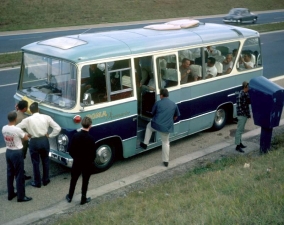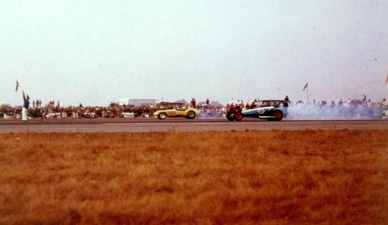
As told exclusively to
Throughout his long career developing hot rodding and drag racing in the United States, Wally Parks kept a detailed journal relating to his candid thoughts at the time. That journal was obtained and edited by his son Richard who has kindly given permission to us to publish extracts from it relating to the period when British Drag Racing was being founded on Eurodragster.com. The opinions are those of Wally, who is referred to by Richard as "Parks" or, occasionally as "my father".
This year is the 60th anniversary of the First British International Drag Festival and this part
takes a look at the race meetings and as Wally says... ‘The wide open airfields were
reminiscent of the early 1950s in the United States, and often cows grazed next to the
airfields. The fans were innocent and wide-eyed, stands were crammed with spectators and
the usual drag racing hijinks were in vogue.’ While it appeared that everything went smoothly
with fans flocking to the Festival making it financially successful, not everything went well.

The story was produced by Richard Parks, photos, images chosen by Nick Pettitt and John Hunt and published by editor of Eurodragster.com Simon Groves. We all thank Jim Miller of the American Hot Rod Foundation for scanning the photos and adding captions.
Glenn Canary of the Goodyear Tire and Rubber Company wrote to Parks on September 1st seeking background information on the drag racers and photographs of their cars for publicity by Goodyear. Parks was very sensitive to the needs of sponsors and sought to give them all the publicity they could use. On September 10th Goodyear made good use of the information sent by the NHRA in a press release through their New York office.
Unfortunately Larry Stellings “missed the boat” and was listed by Parks as a “no show.” Unless he had a good excuse that “missed opportunity” would stick with my father for the rest of his life and sour any good relationship that Stellings had with the NHRA. One does not disappoint the old man and can be easily forgiven.
The car show exhibitions were truly well-done, only as the Brits could manage. The caption on one of the photographs read, “Sydney Allard, 54, builder of Britain’s first dragster, is planning the First British International Drag Festival to take place in September, 1964. The Festival is designed to introduce the dramatic sport of dragging to Europe and at least ten dragsters from America are scheduled to take part.” Wally writes to Hot Rod Magazine...

|

|
Brian Sparrow’s pics from the Leeds show which helped advertise the Drag Festival before the 3rd and 4th rounds at Woodvale in Lancashire and Church Fenton in Yorkshire.

Tommy Ivo’s AA/FD and helmet. |

Dos Palmos with flower arrangements. |

Doug Church displayed his Porsche Dragster complete with trailer. |

Mags and slicks were also on display with the Wedge. |

Even the crashed 22 JR was there next to Garlits. |
Parks and the NHRA had at least $2000 invested, not including what they owed to Dante Duce and salaries of Association officials. He was expecting the amount of sponsorships and BDRA and Festival profits to repay him and he spent some time doodling the amounts in his budget.
Mary Baxter of the Voice & Vision PR firm sent out a press release on September 16th and announced the schedule of races and a Dean Moon interview. The BDRA put out a fine little Program pamphlet covering the Festival for only 2 shillings and sixpence. Let’s see, is it ten pence or twenty to a shilling? And isn’t it sixteen or twenty shillings to a pound? Divide 16, or is it 20 into something… it probably wasn’t much.
Even with the defections of Stellings and Ongais the American Team fielded 11 entrants with Dante Duce, K. S. Pittman and Doug Church stepped up when needed. The photographs were quite revealing; in every sense of the word. The wide open airfields were reminiscent of the early 1950’s in the United States, and often cows grazed next to the airfields.
The fans were innocent and wide- eyed, stands were crammed with spectators and the usual drag racing hijinks were in vogue. This was a trip with only two wives and two children present and so boys will be boys; except that by now they were men.

|

|

|

|

|
The upstanding and moral men managed to sneak into each other’s bedrooms and get a snapshot or two that would go up on the garage wall. One of the photographers visited a burlesque and shot some photographs that the Puritanical Parks blotted out with a marker pen; but his son managed to undo it with an eraser and preserve the “historical” aspect of the trip.
Parks simply couldn’t let the audience back home learn that sex and nudity could mar the integrity of the British Festival or the moral standards of the NHRA. He was like that; always portraying drag racing as pure and good. The photographer managed to capture scenes of the tour and occasionally a pretty blonde or brunette as well.
There is no doubt that in between business, press conferences, banquets and drag racing there was time for sightseeing and a bit of wild oats. This is unconfirmed by the way; only the photographs remain to give another picture; and we shall accept my father’s statement that the men on the tour were well behaved and model citizens. The drag racers and crew members left their signature on a folder and it is now in the files; how cool is that?
National Dragster put out a press release that was likely written by my father in September. The BDRA provided transportation and drivers for the US Team since they are right hand steering wheeled and the Brits drive on the wrong side of the road; at least according to the French (left sided). They provided a Commer (truck brand), 15 cwt diesel van (similar to a Ford van), and a Thames 3 Tonner (also a brand) for Ivo’s heavier car. In addition they had 12 seat vans, trailers, a flat truck and a Plymouth to take drivers, car, crew and passengers from place to place.
The Brits have always been organized, even in defeat, and they study a plan to death and leave no details out. Their schedules are equally meticulous and would satisfy the Bomber commands of WWII. Everything was in its place, unity assured and precision detail demanded of the last man in the chain, or queue as they call it.
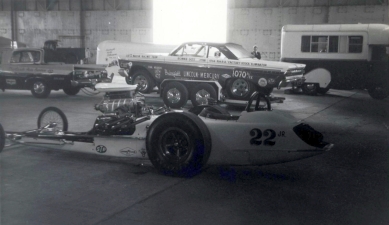
Bob and Roy Phelps FGR Plymouth pickup was used to tow the Sox and Martin A/FX. Brian Sparrow pic. |

Some ex-military 4X4 gun tractors were brought into service to tow the heavier trailers. |

|

|

|
The US Team left their Sandringham Hotel on September 19th and traveled southwest to Blackbushe airport west of London where they raced from 11AM to 5PM and then returned to Sandringham. On the 20th they left the hotel and traveled north to RAF Chelveston in Northamptonshire where they also raced from 11 AM to 5PM before returning to their hotel.
The crowds were estimated around 24,000 spectators by The People newspaper and Don Garlits ran 191mph. The Allard Dragon did beat one American car but the US dragsters were simply too powerful.
Parks sent a postcard to Dismuke on September 23rd , “Here’s a shot of the indoor drag strip – it’s ‘way out.’ We may get a chance to go for some world records here, so I am sticking around. Hope all’s well. It’s COLD here, man! Wally.” There are no more weekend racing schedules but there is a summary report.
Parks wrote down a list of those drivers and crew members who were eligible to receive sponsorship money to offset their expenses; travel, shipping, lodging and food. They were Don and Pat Garlits, Tom Ivo and Tom McCoury, Tony Nancy and Steve Swaja, Bob Keith and Maurice Williamson, Dante Duce and Mike Glennon, Doug Church and Phil Tenwick, George Montgomery and R. Hatch, K. S. Pittman and Chuck Stolze, Dave Strickler and Bill Jenkins, Ronnie Sox and Buddy Martin. Garlits Keith, Church and Montgomery had extra guests that they had to pay for. The two motorcycles and Tony Nancy’s 22 Jr car were separate entries and were not part of the division of sponsorship funds.
While it appeared that everything went smoothly and fans flocked to the Festival making it financially successful, not everything went well if we consider a letter sent to Parks on October 5th by Mike Glennon, “Well, it’s all over now! Today is Monday and that good old ship leaves tomorrow for home. I thought you might like to see the final results of the meets so I sent them along. Unlike everyone else I had a good time!”
The question is what went wrong that caused EVERYONE else but Mike Glennon to have a good time? Or was this just a humorous saying? In Don Garlits autobiography he did not mention having a bad time; in fact he left with the most points. The English scored points for place finishes and Garlits had 494 and beat Tommy Ivo three times. Ivo scored 438 points and beat Garlits twice. Dante Duce crashed and took out some of the timing lights in one race and the times there were not recorded.
The Brits did quite well in the motorcycle races which they seemed to always excel at. While only the Americans broke nine seconds the Allard Dragon managed to get into the tens and the crowds were strong and enjoyed the atmosphere of a big drag race. The effect of the British Festival had achieved its results.
Results sheets...

|

|

|

|
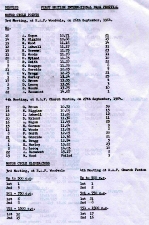
|

|

|

|

|

|

|
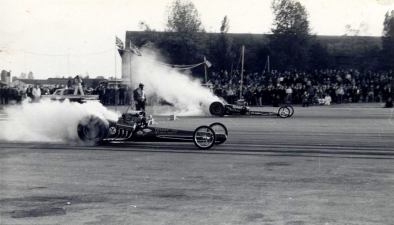
Garlits came out on top with 494 overall points to Ivo’s 438. Brian Sparrow pic. |

Don and Pat with the highest overall points trophy. Paul Hicks pic. |
The press releases are always positive and this one was no different. Weather was good, attendance was great and the Festival was a success; and from all accounts it was, though a bit chilly. The cars ran well, there were no injuries, the boat didn’t sink and I’m sure the participants had a good time, especially the photographer in the burlesque house. Parts did break, some runs were aborted, but that’s a drag race; nothing ever goes perfect.
Don Garlits wrote to Sydney Allard on October 11th but I don’t have the complete letter (only five pages). He came on the trip after being assured that his expenses would be paid, tours to Switzerland and Paris provided, transportation for side trips in England, fuel for the dragster and his wife and two daughters paid for. Part of the problem was the fact that this was new and everyone had to rush after the US Nats to New York City to make the boat. Garlits had given up three weeks of his life for the tour and if he had stayed in the United States to race he could have earned money and not spent it.
If he had gone without his car his expenses would have been much less and he could have greeted the crowds which wanted to see him. He was the reigning US Nats champion and a well-known drag racer. He had been promised first class cabins on the ship but was assigned to tourist class; then the hotels in London were terrible and no bathrooms in the hotel rooms. He found the food and utensils dirty and the wait staff rude.
This was at the height of the Socialist governments and so it is reasonable to assume that perhaps Garlits was correct in his assessment of the British economy with unionization rampant and service lacking. The car he was to use for sightseeing was broken down; he had only one excursion on the entire trip where he had been promised more. The other teams had cars that worked and toured the continent. Garlits was promised fuel for the dragster that never materialized. The net result is that it cost Don over $1400 more to come on this trip than he was paid and it had been a disaster for his family.
It’s a reasonable letter borne out by the bulletins that Duce had sent and admittedly the Garlits family had fallen into one of those mistaken communications and plans that were supposed to have happened, but did not.
I’ve had vacations like that; I think all of us have in our lives. But was the fault due to Sydney Allard, Dante Duce, Wally Parks or simply misfortune, bad luck and worse fate? Would Allard come up with the money to assuage the number one driver in drag racing? Was it Allard’s fault at all? What part did the BDRA play in this situation? Since the crowds were so large, where did the 20% go that was promised to the US team members?
Sydney Allard replied to Garlits on November 4th and sent a copy of the letter to Parks. He was sorry the trip had been such a disappointment and said if he had known he would have tried to do something; he also had scheduled a dinner party for the Garlits but was told they had gone to France. Duce was mistaken, it wasn’t 20% of the GROSS, but of the NET and that always means expenses will eat up the profits. Next year the Festival will need a sponsor able to put up 25,000 Pounds; this year they only got 1,500 Pounds and their expenses were very heavy.
Allard agreed that next year the Festival committee will have to do a better job of ensuring that the American contingent is better taken care of. In any new endeavor there is a learning curve. Don Garlits had some valid points and Sydney Allard and the BDRA did the best that they could under the circumstances. There were some very good points on both sides of the problem.
George Wells wrote to Parks on October 14th and thanked him for the honor of working and serving the British Festival. Wells was in the American military and would be discharged before the next Festival but he offered to return to England to serve again. He thanked Parks for the Official US Racing Team badge and would wear it proudly.

Not only did Nancy lose his 22 JN slingshot he also destroyed three engines in the Wedge during the Festival; here on display at Adlards. Ronald Barker pic. |
Tony Nancy wrote to Parks on November 3rd and thanked my father for the chance to be on the US Racing Team. Nancy was an old pro and his letter was very gracious, “I have never been received so warmly by anyone as I was by the British people.Their hospitality was really great and their understanding was surpassed by none. I hope that all the meetings were a success and that my crew and myself may have contributed a small amount to that success.”
Tony Nancy had several mechanical problems; it was a tough trip but he weathered the tour with grace. Parks replied to Tony on November 6th and noted how much Tony’s equipment had malfunctioned. Then Parks added, “There is no doubt that your two cars were excellent examples of what we wish all American cars looked like. It goes without saying that you, Steve and Mike were among the best representatives we had, and I’m grateful.”
Gerry Belton wrote to Parks on December 29th and the BDRA had planned for a 2nd Annual British Drag Racing Festival for September 19, 25, 26 and October 3rd. The BDRA had learned from the Garlits letter and would make sure that passenger cars were standing by at all times. They would race on only two tracks; one in the north of England and one in the South to make it much more efficient.
The BDRA banquet was coming up soon and he (Belton) asked Parks to make a short speech and send it to him to read to the membership. He also asked if Parks could send him a film of the US Nats to show to the BDRA. Belton asked if the BDRA members could join the NHRA and receive the National Dragster which would help their recruitment.
Dante Duce wanted to drive the Allard Dragon dragster, but “we feel that he now has a rather unfortunate image which might not help us. A shame.” Was that image due to the Garlits situation and complaint or the accident that he had in the sports car? It was a shame as Dante was a good organizer who couldn’t control the unraveling problems in the First British Festival.
Four decades later Parks recalled the exploits of the first British International Drag Festival in a letter to John Jodauga on July 16th, 2003. Dad began, “John: FYI, The first British international Drag Festival was inspired by Dean Moon, who had taken his ‘Mooneyes’ dragster to England in 1963 to participate in speed trials held on Brighton Beach. There he became acquainted with Sydney Allard, one of England’s most avid motorsports enthusiasts and an active contender in many of its racing forms. In the course of their conversations Moon suggested the prospect of inviting some American drag racers to England for the following year’s activity.
"The idea was accepted with Dean as a volunteer spokesman to help get a program in motion, with the newly formed British Drag Racing Association as its host organization. Returning home, Dean contacted Wally Parks, ex-editor of Hot Rod Magazine and founder of the National Hot Rod Association, who saw the project’s merits and offered his and NHRA’s assistance in getting it going.
When some supporting sponsorships were needed to help offset expenses, it was Goodyear, Mobil, Valvoline and STP who pitched in. With the British Drag Festival underwriting transportation and lodging for team members and race cars, a next step was that of selecting which of America’s outstanding cars and drag racers would be chosen for what would be known as the 1964 NHRA United States Drag Racing Team.
"A selection of cars was made in pairs representing the most popular competition classes of US drag racing. The 1964 US team included Tony Nancy, Tommy Ivo, Don Garlits, Bob Keith, George Montgomery, KS Pittman, Ronnie Sox, Dave Strickler and Dante Duce.
"Events were held over three weekends, mostly at unused RAF airport runways, at places like Blackbushe, Chelveston, Woodvale and Church Fenton, conducted by the BDRA with RAF Motorsports Club in supervision of record attempts. Able event director was Dante Duce, a Las Vegas speed shop owner (who may still be in business as Duce’s Speed Shop). He could give you lots of info on the ’63 and ’64 action (he drove ‘Mooneyes’ in ’63).”

|

|
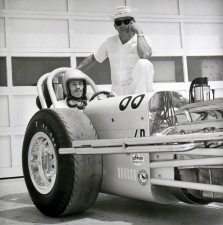
Dante Duce and Dean Moon. Photo courtesy of MOONEYES archives. |
Parks followed up with another letter to Jodauga on January 20, 2004, “John: The fax photos are unclear, but I don’t recognize the guy on the left. Nor do I think it is Sydney Allard. But it may be Goodyear’s Tony Webner on the right. The other shot is at 1963 Brighton Speed Trials, where Dean was invited to run his Mooneyes dragster. Car shown is Allard's dragster. This event hatched the prospect of sending a US Drag Racing Team in 1964, which Sydney Allard supported.
"Moon brought the idea to me and I agreed to help organize, solicit some sponsors and select prominent NHRA racers to take part, including Tony Nancy, Tommy Ivo, Don Garlits, George Montgomery, KS Pittman, Sox & Martin, Dave Strickler and Bob Keith.
"We chose Dante Duce as racing coordinator for the US Drag Racing Team. Webner supplied Goodyear tires and helped coordinate cars’ shipment. The following year’s US Drag Racing Team participation in the BDRA event was under SEMA’s sponsorship. I am concerned about accuracy in your reliance on interviews, after all these years, and would appreciate a preview of your story’s copy -- either by fax or on-line.”
Feature ©Eurodragster.com
Wally Parks' story - Part 1
Wally Parks' story - Part 2
Wally Parks' story - Part 3
Back to pioneers index
Back to News page
